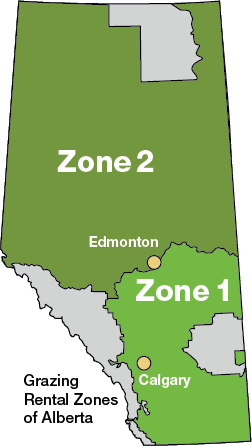Non-urgent government operations are closed December 24 to January 1, reopening January 2. View available services during this period.
Overview
The Public Lands Modernization (Grazing Leases and Obsolete Provisions) Amendment Act updated Alberta’s grazing disposition rental rates and fee framework. This framework determines the amount of rents and fees grazing disposition holders pay to the government for the use of public rangeland.
The framework was developed with stakeholders in acknowledgement of the stewardship efforts of disposition holders, and to ensure that the new framework was transparent and fair. The grazing rental framework is based on cattle markets and reflects the economic reality of managing a disposition, while ensuring Albertans get fair value for the use of the province’s resources.
The government supports rangeland sustainability and proactively invests 30% of grazing disposition rental revenue above $2.9 million into rangeland sustainability initiatives through the Rangeland Sustainability Program.
New rates
Rental rate changes impact:
- grazing leases (GRL)
- grazing licences (FGL)
- grazing permits (GRP)
Rental rate changes do not impact:
- forest reserve grazing permits
- head tax permits (HTP)
- provincial grazing reserves (PGR)
These three types of grazing dispositions have a different fee structure due to differences in disposition holder rights and requirements.

Under the framework, there are two grazing rental rate zones based on the transition of the boreal region of the province, an area that incurs higher costs on grazing dispositions. Zone 1 (South) and Zone 2 (North) are divided by the North Saskatchewan River.
The implementation of the new rental rate structure aligns with the cost of holding a grazing disposition and market fluctuations – so when cattle markets are down, so are rental rates.
Although rent is calculated on an annual basis, there is a minimum grazing rent charge:
- $2.30 in Zone 1
- $1.30 in Zone 2
Rental rates are tied directly to annual cattle markets. When cattle prices rise, rent increases and the formula captures a greater share of potential profits from grazing on Crown land.
Rental rate changes for 2025
| Previous zone | New zone | New minimum rate (per Animal Unit Month) | Old minimum rate (per Animal Unit Month) | 2022 rates (per Animal Unit Month) | 2023 rates (per Animal Unit Month) | 2024 rates (per Animal Unit Month) | 2025 rates (per Animal Unit Month) |
|---|---|---|---|---|---|---|---|
| Zone A (Southern Alberta) | Zone 1 | $2.30/AUM | $2.79/AUM | $3.25/AUM | $4.58/AUM | $7.63/AUM | $8.70/AUM |
| Zone B (Central Alberta) | Zone 1 | $2.30/AUM | $2.32/AUM | $3.25/AUM | $4.58/AUM | $7.63/AUM | $8.70/AUM |
| Zone C (Northern Alberta) | Zone 2 | $1.30/AUM | $1.39/AUM | $1.94/AUM | $3.08/AUM | $4.99/AUM | $6.07/AUM |
Assignment fee
As of 2020, the application fee to transfer a grazing disposition to someone else (family and non-family assignment) is a flat rate of $3,150, in alignment with the assignment fee for all other public land dispositions assignable under the Public Lands Act.
Grazing rental formula
The rental rate framework calculates lease rents based on the profitability of operating a grazing lease, considering market prices, transportation, and operating and labour costs.
To calculate rent we use a model based on:
- the purchase of yearlings in the spring
- weight gain on the lease during the grazing season
- sale price in the fall
Although there is considerable variability in how cattle operations and grazing leases are managed across the province, this standard was chosen to provide consistency.
Inputs to the model come from actual market reports (example: Canfax) and take into account long-standing cycles between spring and fall markets, as well as yearling and calf markets. Grazing lease cost surveys provide inputs to the model such as:
- weight gain on the lease
- direct and indirect operating costs
The most recent survey in 2021 was funded by the province and delivered through contracted services. The grazing lease rental rate varies as net revenue from cattle (steers) minus additional input costs and grazing lease operating costs (example: profitability) either increases or decreases.
There are 3 key calculations used to determine rental rate under the grazing disposition rental rate framework:
| Key calculation | Inputs | Output |
|---|---|---|
| Net revenue calculation | Canfax steer prices (Market prices: 850 lb sale weight minus 650 lb purchase weight) = Weight gain from purchase to sale | Net revenue earned by rancher from cattle grazing on lease |
| Operating cost calculation | Direct costs + Indirect costs | Operating costs incurred by rancher whose cattle graze on the lease Return on investment (ROI) is calculated for the lease |
| Rental rate calculation | Return on investment (ROI) + Rental rate tiers1, including minimum rent | Public lands grazing lease rental payment |